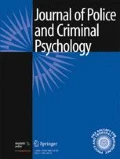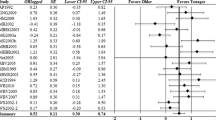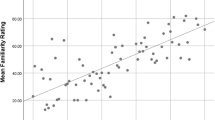Abstract
Most eyewitness research focuses on stranger identifications, despite the fact that eyewitnesses may also be asked to identify a familiar person. The current study examined the role of eyewitness-perpetrator familiarity and line-up procedure on adolescent eyewitness identification accuracy. Familiarity was manipulated wherein participants (N = 623) directly interacted, indirectly interacted, or did not meet a confederate before viewing the confederate commit a mock crime. Lineup procedure (simultaneous, sequential, elimination-plus) and target presence were manipulated. Familiarity increased the likelihood of correct identifications in target-present lineups when the sequential lineup procedure was used, whereas familiarity increased the likelihood of correct rejections in target-absent lineups when the simultaneous or elimination-plus procedures were used. These findings suggest that familiarity with a perpetrator can influence identification accuracy.
Similar content being viewed by others
Data Availability
The data reported has been used previously as part of the first author’s doctoral dissertation.
Notes
The simultaneous lineup procedure was used as the reference group.
References
Beal CR, Schmitt KL, Dekle DJ (1995) Eyewitness identification of children: effects of absolute judgments, nonverbal response options, and event encoding. Law Hum Behav 19:197–216. https://doi.org/10.1007/BF01499325
Beaudry JL, Lindsay RCL (2006) Current identification procedure practices: a survey of Ontario police officers. The Canadian Journal of Police & Security Services 4:178–183
Beaudry JL, Lindsay RCL, Leach A, Mansour JK, Bertrand MI, Kamlet N (2015) The effect of evidence type, identification accuracy, line-up presentation, and lineup administration on observers’ perceptions of eyewitnesses. Leg Criminol Psychol 20:343–364. https://doi.org/10.1111/lcrp.12030
Bornstein BH, Deffenbacher KA, Penrod SD, McGorty EK (2012) Effects of exposure time and cognitive operations on facial identification accuracy: a meta-analysis of two variables associated with initial memory strength. Psychol Crime Law 18:473–490. https://doi.org/10.1080/106831X.2010.508458
Cain WJ, Baker-Ward L, Eaton KL (2005) A face in the crowd: the influences of familiarity and delay on preschoolers’ recognition. Psychol Crime Law 11:315–327. https://doi.org/10.1080/10683160418331294835
Clark SE (2012) Costs and benefits of eyewitness identification reform: psychological science and public policy. Perspect Psychol Sci 7:238–259. https://doi.org/10.1177/1745691612439584
Conklin HM, Luciana M, Hooper CJ, Yarger RS (2007) Working memory performance in typically developing children and adolescents: behavioural evidence of protracted frontal lobe development. Dev Neuropsychol 31:103–128. https://doi.org/10.1207/s15326942dn3101_6
Dunlevy JR, Cherryman J (2013) Target-absent eyewitness identification line-ups: why do children like to choose? Psychiatry Psychol Law 20:284–293. https://doi.org/10.1080/13218719.2012.671584
Fitzgerald RJ, Price HL (2015) Eyewitness identification across the lifespan: a meta-analysis of age differences. Psychol Bull 141:1228–1265. https://doi.org/10.1037/bu0000013
Flowe HR, Mehta A, Ebbesen EB (2011) The role of eyewitness identification evidence in felony case dispositions. Psychol Public Policy Law 17:140–159. https://doi.org/10.1097/a00121311
Gronlund SD, Andersen SM, Perry C (2013) Presentation methods. In B. L. Cutler (ed.), Reform of eyewitness identification procedures (pp. 113–138). US: American Psychological Association. https://doi.org/10.1037/14094-006
Grisso T, Steinberg S, Woolard J, Cauffman E, Scott E, Schwartz R (2003) Juveniles’ competence to stand trial: a comparison of adolescents’ and adults’ capacities as trial defendants. Law Hum Behav 27:333–363. https://doi.org/10.1023/A:1024065015717
Havard C (2014) Are children less reliable at making visual identifications than adults? A review. Psychol Crime Law 20:372–388. https://doi.org/10.1080/1068316X.2013.793334
Havard C, Memon A, Clifford B, Gabbert F (2010) A comparison of video and static photo lineups with child and adolescent witnesses. Appl Cogn Psychol 24:1209–1221. https://doi.org/10.1002/acp.1645
Horry R, Halford P, Brewer N, Milne R, Bull R (2014) Archival analyses of eyewitness identification test outcomes: what can they tell us about eyewitness memory? Law Hum Behav 38:94–108. https://doi.org/10.1037/lhb0000060
Humphries JE, Holliday RE, Flowe HD (2012) Faces in motion: age-related changes in eyewitness identification performance in simultaneous, sequential, and elimination video lineups. Appl Cogn Psychol 26:149–158. https://doi.org/10.1002/acp.1808
Jack F, Leov J, Zajac R (2014) Age-related differences in the free-recall accounts of child, adolescent, and adult witnesses. Appl Cogn Psychol 28:30–38. https://doi.org/10.1002/acp.2951
Johnston RA, Edmonds AJ (2009) Familiar and unfamiliar face recognition: a review. Memory 17:577–596. https://doi.org/10.1080/09658210902976969
Lander K, Bruce V (2000) Recognising famous faces: exploring the benefits of facial motion. Ecol Psychol 12:259–272. https://doi.org/10.1207/S15326969ECO1204_01
Lindsay RCL, Pozzulo JD, Craig W, Lee K, Corber S (1997) Simultaneous lineups, sequential lineups, and showups: eyewitness identification decisions of adults and children. Law Hum Behav 21:391–404. https://doi.org/10.1023/A:1024807202926
Lindsay RCL, Wells GL (1985) Improving eyewitness identification from lineups: simultaneous and sequential lineup presentation. J Appl Psychol 70:556–564. https://doi.org/10.1037/0021-9010.70.3.556
Luus CAE, Wells GL (1991) Eyewitness identification and the selection of distracters for lineups. Law Hum Behav 15:43–57
Mandler G (2008) Familiarity breeds attempts: a critical review of dual-process theories of recognition. Perspect Psychol Sci 3:390–399. https://doi.org/10.1111/j.1745-6924.2008.00087.x
Meissner CA, Tredoux CG, Parker JF, MacLin O (2005) Eyewitness decisions in simultaneous and sequential lineups: a dual-process signal detection theory analysis. Mem Cognit 33:783–792. https://doi.org/10.3758/BF03193074
Memon A, Havard C, Clifford B, Gabbert F, Wyatt M (2011) A field evaluation of the VIPER system: a new technique for eliciting eyewitness identification evidence. Psychol Crime Law 17:711–729. https://doi.org/10.1080/10683160903524333
National Academy of Sciences (2014) Identifying the culprit: assessing eyewitness identification. National Academies Press, Washington, DC, US
Palmer MA, Brewer N (2012) Sequential lineup presentation promotes less-biased criterion setting but does not improve discriminability. Law Hum Behav 36:245–255. https://doi.org/10.1037/h0093923
Paus T (2005) Mapping brain maturation and cognitive development during adolescence. Trends Cogn Sci 9:60–68. https://doi.org/10.1016/j.tics.2004.12.008
Perrault S (2015) Criminal Victimization in Canada, 2014. Statistics Canada. https://www.statcan.gc.ca/pub/85-002-x/2015001/article/14241-eng.htm#a8
Perrault S, Brennan S (2010). Criminal victimization in Canada, 2009. Retrieved from: https://www150.statcan.gc.ca/n1/pub/85-002-x/2010002/article/11340-eng.htm#a3
Pezdek K, Stolzenberg S (2014) Are individuals’ familiarity judgments diagnostic of prior contact? Psychol Crime Law 20:302–314. https://doi.org/10.1080/1068316X.2013.772181
Pica E, Pozzulo JD (2017) The elimination-plus lineup: testing a modified lineup procedure with confidence. J Investig Psychol Offender Profiling 14:294–306. https://doi.org/10.1002/jip.1477
Pozzulo JD (2016) The young eyewitness – how well do children and adolescents describe and identify perpetrators. American Psychological Association, Washington, D.C.
Pozzulo JD, Dempsey J, Bruer K, Sheahan C (2012) The culprit in target-absent lineups: understanding children’s false positive responding. J Police Crim Psychol 27:55–62. https://doi.org/10.1007/s11896-011-9089-8
Pozzulo JD, Dempsey J, Crescini C (2009) Preschoolers’ person description and identification accuracy: a comparison of the simultaneous and elimination lineup procedures. J Appl Dev Psychol 30:667–676. https://doi.org/10.1016/j.appdev.2009.01.004
Pozzulo JD, Dempsey J, Pettalia J (2013) The Z generation: examining perpetrator descriptions and lineup identification procedures. J Police Crim Psychol 28:63–74. https://doi.org/10.1007/s11896-012-9107-5
Pozzulo JD, Lindsay RCL (1998) Identification accuracy of children versus adults: a meta-analysis. Law Hum Behav 22:549–570. https://doi.org/10.1023/A:1025739514042
Pozzulo JD, Lindsay RCL (1999) Elimination lineups: an improved identification procedure for child eyewitnesses. J Appl Psychol 84:167–176. https://doi.org/10.1037/0021-9010.84.2.167
Pozzulo JD, Reed J, Pettalia J, Dempsey J (2015) Simultaneous, sequential, elimination, and wildcard: a comparison of lineup procedures. J Police Crim Psychol 31:71–80. https://doi.org/10.1007/s11896-015-9168-3
Pozzulo JD, Pica E, Sheahan CL (2019) Familiarity and conviction in the criminal justice system: definitions, theory, and eyewitness research. Oxford University Press. https://doi.org/10.1093/oso/97801908748100.001.0001
Schneider W, Knopf M, Stefanek J (2002) The development of verbal memory in childhood and adolescence: findings from the Munich longitudinal study. J Educ Psychol 94:751–761. https://doi.org/10.1037//0022-0663.94.4.751
Semmler C, Brewer N, Douglass AB (2012) Jurors believe eyewitnesses. In Cutler BL (Ed.) Conviction of the innocent: lessons learned from psychological research (pp.185–209). US: American Psychological Association. https://doi.org/10.1037/13085-009
Sheahan CL, Pica E, Pozzulo JD, Nastasa C (2017) Eyewitness recall and identification abilities of adolescent and young-adults. J Appl Dev Psychol 53:86–95. https://doi.org/10.1016/j.appdev.2017.09.008
Sporer SL (1993) Eyewitness identification accuracy, confidence, and decision times in simultaneous and sequential lineups. J Appl Psychol 78:22–33. https://doi.org/10.1037/0021-9010.78.1.22
Statistics Canada (2008) Children and youth. http://www.statcan.gc.ca/pub/11-402-x/2008000/pdf/children-enfants-eng.pdf
Steblay N (2013) Lineup instructions. In B.L. (ed.), Reform of eyewitness identification procedures (pp.65–86). US: American Psychological Association. https://doi.org/10.1037/14094-004
Steblay N, Dysart J, Fulero S, Lindsay RCL (2001) Eyewitness accuracy rates in sequential and simultaneous lineup presentations: a meta-analytic comparison. Law Hum Behav 25:459–473. https://doi.org/10.1023/A:1012888715007
Steblay NK, Dietrich HL, Ryan SL, Raczynski JL, James KA (2011a) Sequential lineup laps and eyewitness accuracy. Law Hum Behav 35:262–274. https://doi.org/10.1007/s10979-010-9236-2
Steblay NK, Dysart JE, Wells GL (2011b) Seventy-two tests of the sequential lineup superiority effect: a meta-analysis and policy discussion. Psychol Public Policy Law 17:99–193. https://doi.org/10.1037/a0021650
Steinberg L (2005) Cognitive and affective development in adolescence. Trends Cogn Sci 9:69–74. https://doi.org/10.1016/j.tics.2004.12.005
Steinberg L, Cauffman E (1996) Maturity of judgment in adolescence: psychosocial factors in adolescent decision making. Law Hum Behav 20:249–272. https://doi.org/10.1007/BF01499023
Sugiura M, Mano Y, Sasaki A, Sadato N (2011) Beyond the memory mechanism: person-selective and nonselected processes in recognition of personally familiar faces. J Cogn Neurosci 23:699–715. https://doi.org/10.1162/jocn.2010.21469
Technical Working Groups for Eyewitness Evidence (2003) Eyewitness evidence: a trainer’s manual for law enforcement. U.S. Department of Justice. https://www.ncjrs.gov/nij/eyewitness/188678.pdf
The Innocence Project. (n.d.). Eyewitness identification reform. https://innocenceproject.org/eyewitness-identification-reform/
Tredoux CG (1998) Statistical inference on measures of lineup fairness. Law Hum Behav 22:217–237. https://doi.org/10.1023/A:1025746220886
White N, Lauritsen J (2012) Violent crime against youth, 1994–2010. U.S. Department of Justice. http://www.bjs.gov/content/pub/pdf/vcay9410.pdf
Valentine T, Pickering A, Darling S (2003) Characteristics of eyewitness identification that predict the outcome of real lineups. Appl Cogn Psychol 17:969–993. https://doi.org/10.1002/acp.939
Wells GL (1984) The psychology of lineup identifications. J Appl Soc Psychol 14:89–103. https://doi.org/10.1111/j.1559-1816.1984.tb.02223.x1816
Wells GL (1978) Applied eyewitness-testimony research: System variables and estimator variables. J Pers Soc Psychol 36:1546–1557
Wells GL (1993) What do we know about eyewitness identification? Am Psychol 48:553–571. https://doi.org/10.1037/0003-066X.48.5.553
Wells GL, Luus CAE (1990) Police lineups as experiments: social methodology as a framework for properly conducted lineups. Pers Soc Psychol Bull 16:106–117. https://doi.org/10.1177/0146167290161008
Wells GL, Olson E (2003) Eyewitness testimony. Annu Rev Psychol 54:277–597. https://doi.org/10.1146/annurev.psych.54.101601.145028
Wells GL, Steblay NK, Dysart JE (2015a) Double-blind photo lineups using actual eyewitnesses: an experimental test of a sequential versus simultaneous lineup procedure. Law Hum Behav 39:1–14. https://doi.org/10.1037/lhb0000096
Wells GL, Dysart JE, Steblay NK (2015b) The flaw in Amendola and Wixted’s conclusion on simultaneous versus sequential lineups. J Exp Criminol 11:285–289. https://doi.org/10.1007/s11292-014-9225-4
Wells GL, Small M, Penrod S, Malpass RS, Fulero SM, Brimacombe CAE (1998) Eyewitness identification procedures: Recommendations for lineups and photospreads. Law Hum Behav 22:603–647
Zimmerman, D., Austin, J.L., & Kovera, M. B. (2012). Suggestive eyewitness identification procedures. In B.L. Cutler (Ed.), Conviction of the innocent: Lessons from psychological research (pp. 125–148). US: American Psychological Association. https://doi.org/10.1037/13085-000
Funding
This work was supported by the Social Sciences and Humanities Research Council (SSHRC) Doctoral Fellowship [award number 752-2014-1918].
Author information
Authors and Affiliations
Corresponding author
Ethics declarations
Ethical Approval
All procedures performed in studies involving human participants were in accordance with the ethical standards of the institution and/or national research committee and with the 1964 Helsinki declaration and its later amendments or comparable ethical standards. This article does not contain any studies with animals performed by any of the authors. This study was approved by the Carleton University Research Ethics Board-B (#105287).
Informed Consent
Informed consent was obtained from all individual participants included in the study.
Conflict of Interest
The authors declare that they have no conflict of interest.
Additional information
Publisher’s Note
Springer Nature remains neutral with regard to jurisdictional claims in published maps and institutional affiliations.
Rights and permissions
About this article
Cite this article
Sheahan, C.L., Pozzulo, J.D. & Pica, E. Can Familiarity Between an Adolescent Eyewitness and a Perpetrator Influence Identification Accuracy?. J Police Crim Psych 37, 325–338 (2022). https://doi.org/10.1007/s11896-021-09440-3
Accepted:
Published:
Issue Date:
DOI: https://doi.org/10.1007/s11896-021-09440-3




